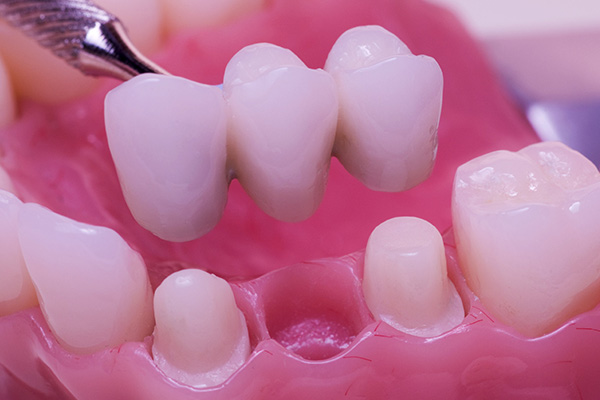Are There Different Types of Dental Bridge?

A dental bridge is a method of replacing one or more lost teeth. People often use the word bridge to indicate a removable tooth replacement option, but dentists have a different opinion. Dental professionals consider bridges as a device that attaches to the teeth permanently and is not removable — at least not by patients. There are different bridge options in terms of design and material, all of which serve the same purpose.
An overview of dental bridges
In every type of dental bridge, the replacement tooth is known as the pontic. The pontic provides tooth functions and attaches to underlying support through retainers or abutments (the structure varies based on the type of dental bridge). Every bridge needs adjacent structures for support, and the pontic lies on top of the gum tissue. Some of the dental bridge options available include the below.
Traditional bridge
The traditional bridge is the most popular type of bridge. It uses dental crowns to cover the teeth on the two sides of the gap. The pontic attaches to the abutment crowns so that the bridge becomes a large unit. The number of pontic depends on the number of missing teeth; together with the retainer crowns, the traditional bridge for a single missing tooth is a three-unit setup.
Traditional bridges should only be used for one or two missing teeth. The strength of the bridge depends on the supporting structures (root and gum) of the abutment teeth.
Cantilever bridge
A cantilever bridge utilizes one abutment tooth on one side of the gap. This means the pontic has only one attachment to a healthy tooth. The strongest tooth near the area gets a dental crown and provides the support needed. This option works better for small teeth that experience minimal chewing forces.
Possible flexing is one of the drawbacks of cantilever bridges. There are rare cases where the cantilever bridge survives several years of use. In most cases, the flexing and chewing forces acceptable by the structure of the cantilever eventually displace the bridge or damage the supporting retainer tooth.
Maryland bridge
This is a variation of the traditional bridge. It uses small wings to hold the pontic, instead of complete dental crowns. The wings lie on the biting surface of the nearby teeth and fixed with dental cement. They are effective options for replacing one front tooth and are highly conservative. They require minimal or zero removal of healthy tooth structure.
Maryland bridges are not suitable for back teeth since the heavy chewing forces can dislodge them. If they are used, it is usually a temporary solution. The drawback of this bridge is the risk of debonding and falling out. Since they are mostly used for front teeth, it can lead to an embarrassing situation.
Implant-supported bridge
An implant-supported bridge is like a regular bridge but uses dental implants for support, instead of adjacent teeth. It is an excellent choice for those who have lost multiple teeth since only two implants can support a bridge with four or more pontics. The main benefit is that they have a lower failure rate and provide better support for chewing.
Ready to get started with a dental bridge?
If you have missing teeth and are considering dental bridge, contact our dental office to schedule a consultation with the dentist.
Request an appointment here: http://www.riversdentistry.com or call Rivers Family Dentistry at (979) 710-2216 for an appointment in our Bryan office.
Check out what others are saying about our dental services on Yelp: Dental Bridges in Bryan, TX.
Related Posts
There are many ways to replace lost teeth, and dental bridges are an effective and long-lasting option for people looking to replace missing teeth. Bridges can help restore both the appearance and function of your smile. Learning about the basics, uses, and benefits of bridges can help you decide if they are the right choice…
There are various reasons why a dental bridge might be recommended. A dentist might advise you to get one if you have multiple missing teeth next to each other (typically no more than three) and your budget is not enough to cover implants.A dental bridge might also be recommended if a dentist deems you are…
The same day crown, like a regular crown, is essentially designed to be a cap for a permanent tooth. It is designed to look and act like a natural tooth and can restore a damaged tooth's strength, function, and look.Usually, getting a crown involves fitting two dentist visits into your hectic schedule. In the first…
The same day crown procedure is ideal if you would like to get a dental crown without multiple dental appointments. This same day crown manufacturing and attachment method is completed in one dental visit and can be incredibly time-saving. It helps to have an overview of the process of getting same day crown before visiting…


